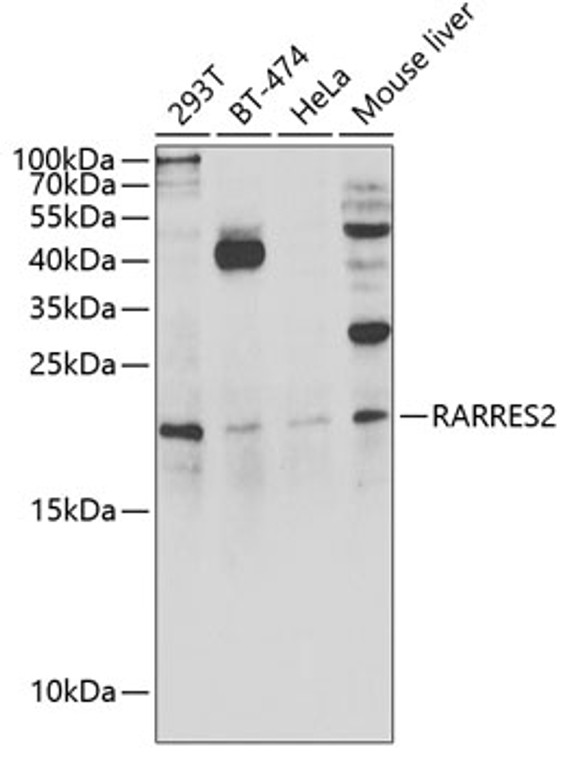| Host: |
Rabbit |
| Applications: |
WB/IF |
| Reactivity: |
Human/Mouse |
| Note: |
STRICTLY FOR FURTHER SCIENTIFIC RESEARCH USE ONLY (RUO). MUST NOT TO BE USED IN DIAGNOSTIC OR THERAPEUTIC APPLICATIONS. |
| Short Description: |
Rabbit polyclonal antibody anti-RARRES2 (17-163) is suitable for use in Western Blot and Immunofluorescence research applications. |
| Clonality: |
Polyclonal |
| Conjugation: |
Unconjugated |
| Isotype: |
IgG |
| Formulation: |
PBS with 0.05% Proclin300, 50% Glycerol, pH7.3. |
| Purification: |
Affinity purification |
| Dilution Range: |
WB 1:500-1:2000IF/ICC 1:50-1:200 |
| Storage Instruction: |
Store at-20°C for up to 1 year from the date of receipt, and avoid repeat freeze-thaw cycles. |
| Gene Symbol: |
RARRES2 |
| Gene ID: |
5919 |
| Uniprot ID: |
RARR2_HUMAN |
| Immunogen Region: |
17-163 |
| Immunogen: |
Recombinant fusion protein containing a sequence corresponding to amino acids 17-163 of human RARRES2 (NP_002880.1). |
| Immunogen Sequence: |
VGVAELTEAQRRGLQVALEE FHKHPPVQWAFQETSVESAV DTPFPAGIFVRLEFKLQQTS CRKRDWKKPECKVRPNGRKR KCLACIKLGSEDKVLGRLVH CPIETQVLREAEEHQETQCL RVQRAGEDPHSFYFPGQFAF SKALPRS |
| Tissue Specificity | Expressed at the highest levels in placenta, liver, and white adipose tissue (WAT), and to a lesser extent in many other tissues such as lung, brown adipose tissue, heart, ovary, kidney, skeletal muscle and pancreas. Within WAT, expression is enriched in adipocytes as compared to the stromal vascular fraction. Expression and secretion increases dramatically with adipogenesis. Highly expressed in skin (basal and suprabasal layers of the epidermis, hair follicles and endothelial cells). Expression is elevated in numerous metabolic and inflammatory diseases including psoriasis, obesity, type 2 diabetes, metabolic syndrome and cardiovascular disease. |
| Post Translational Modifications | Secreted in an inactive precursor form, prochemerin, which is proteolytically processed by a variety of extracellular proteases to generate forms with differing levels of bioactivity. For example, the removal of six amino acids results in chemerin-157, which exhibits the highest activity, while removal of seven amino acids results in chemerin-156 which has slightly less activity. Some proteases are able to cleave at more than one site and chemerin forms may be sequentially processed by different enzymes to modulate activity levels. The coordinated expression and activity of chemerin-modifying enzymes is essential for regulating its bioactivation, inactivation and, consequently, biological function. Cathepsin G cleaves seven C-terminal amino acids from prochemerin (chemerin-156), elastase is able to cleave six (chemerin-157), eight (chemerin-155) or eleven (chemerin-152), plasmin cleaves five amino acids (chemerin-158), and tryptase cleaves five (chemerin-158) or eight (chemerin-155). Multiple cleavages might be required to fully activate chemerin, with an initial tryptase cleavage resulting in chemerin with low activity (chemerin-158), and a second cleavage by carboxypeptidase N or B producing highly active chemerin (chemerin-157). |
| Function | Adipocyte-secreted protein (adipokine) that regulates adipogenesis, metabolism and inflammation through activation of the chemokine-like receptor 1 (CMKLR1). Acts also as a ligand for CMKLR2. Can also bind to C-C chemokine receptor-like 2 (CCRL2), but with a lower affinity than it does to CMKLR1 or CMKLR2. Positively regulates adipocyte differentiation, modulates the expression of adipocyte genes involved in lipid and glucose metabolism and might play a role in angiogenesis, a process essential for the expansion of white adipose tissue. Also acts as a pro-inflammatory adipokine, causing an increase in secretion of pro-inflammatory and prodiabetic adipokines, which further impair adipose tissue metabolic function and have negative systemic effects including impaired insulin sensitivity, altered glucose and lipid metabolism, and a decrease in vascular function in other tissues. Can have both pro- and anti-inflammatory properties depending on the modality of enzymatic cleavage by different classes of proteases. Acts as a chemotactic factor for leukocyte populations expressing CMKLR1, particularly immature plasmacytoid dendritic cells, but also immature myeloid DCs, macrophages and natural killer cells. Exerts an anti-inflammatory role by preventing TNF/TNFA-induced VCAM1 expression and monocytes adhesion in vascular endothelial cells. The effect is mediated via inhibiting activation of NF-kappa-B and CRK/p38 through stimulation of AKT1/NOS3 signaling and nitric oxide production. Its dual role in inflammation and metabolism might provide a link between chronic inflammation and obesity, as well as obesity-related disorders such as type 2 diabetes and cardiovascular disease. Exhibits an antimicrobial function in the skin. |
| Protein Name | Retinoic Acid Receptor Responder Protein 2ChemerinRar-Responsive Protein Tig2Tazarotene-Induced Gene 2 Protein |
| Database Links | Reactome: R-HSA-114608 |
| Cellular Localisation | Secreted |
| Alternative Antibody Names | Anti-Retinoic Acid Receptor Responder Protein 2 antibodyAnti-Chemerin antibodyAnti-Rar-Responsive Protein Tig2 antibodyAnti-Tazarotene-Induced Gene 2 Protein antibodyAnti-RARRES2 antibodyAnti-TIG2 antibody |
Information sourced from Uniprot.org
12 months for antibodies. 6 months for ELISA Kits. Please see website T&Cs for further guidance









